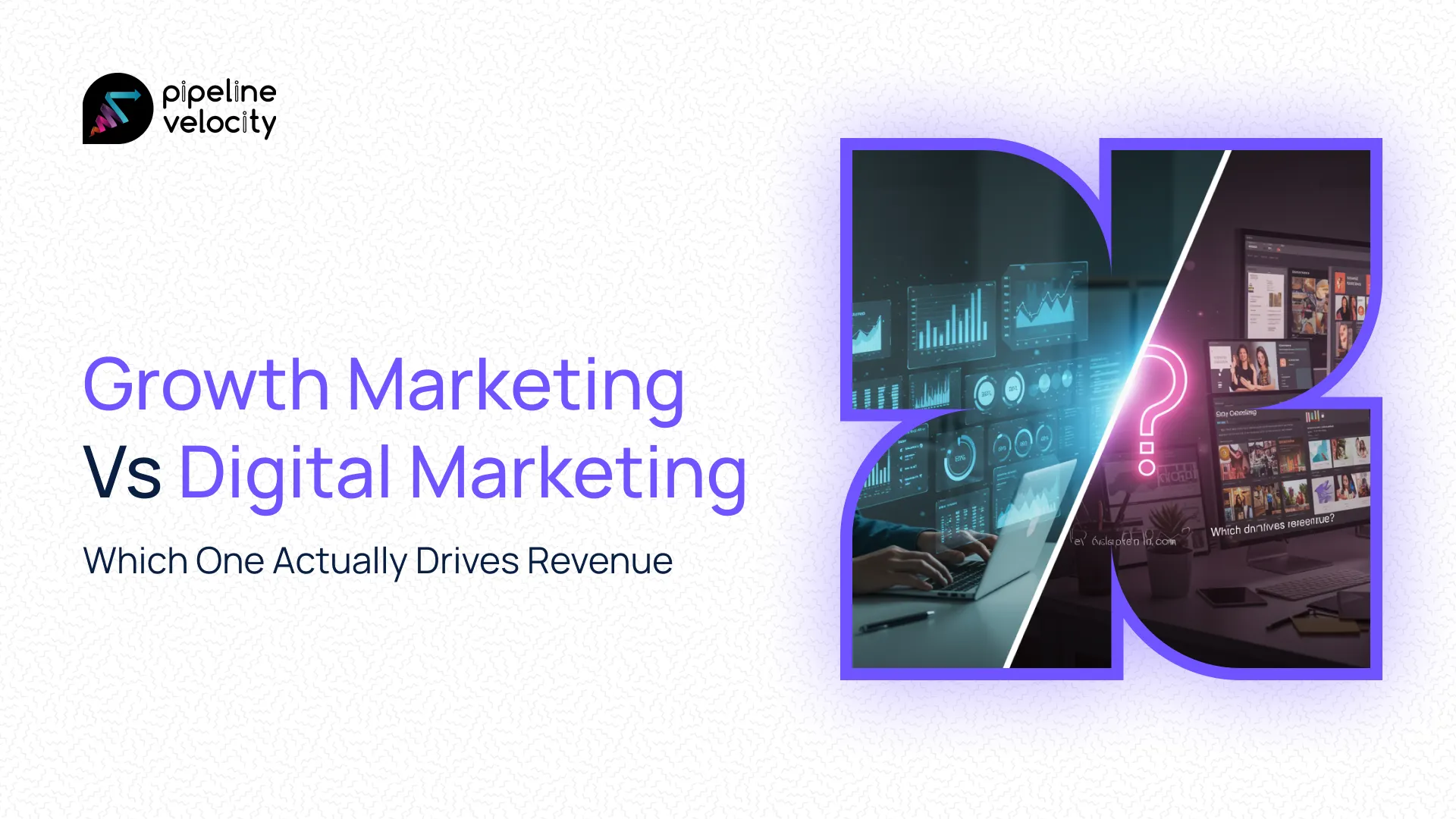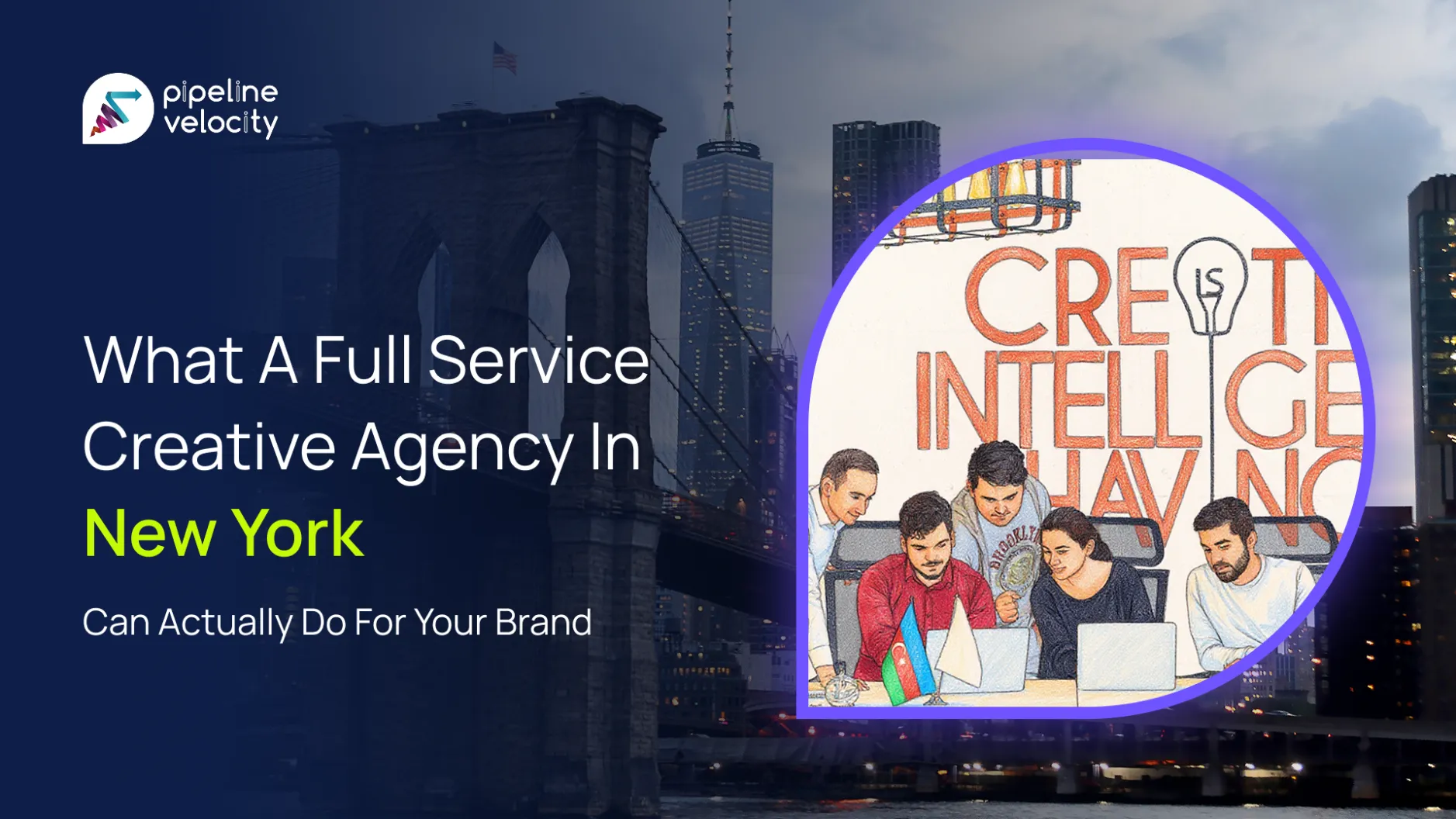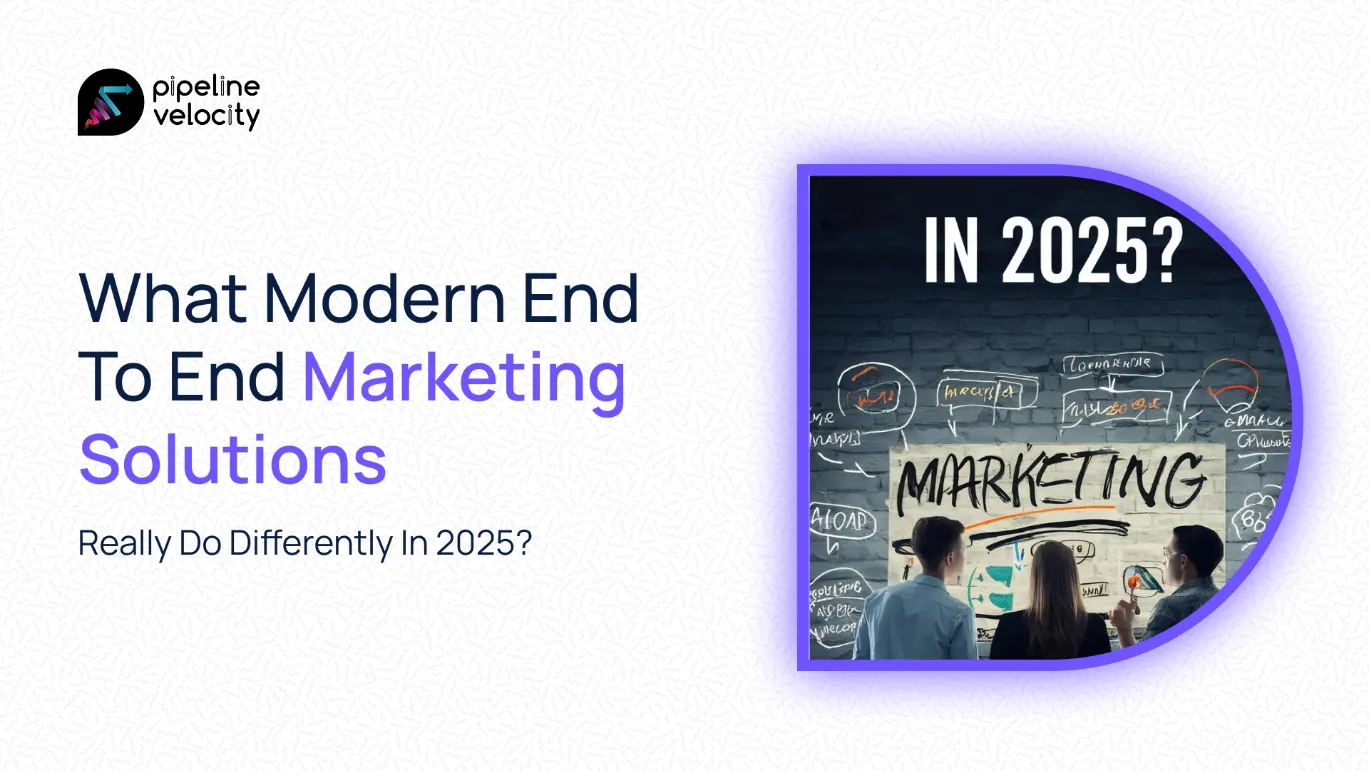How Pipeline Velocity Helps New York Brands Win
Our services at Pipeline Velocity pair strategy with execution so you get results without vendor sprawl. We map the plan, then run the work across growth marketing services, SEO services, PPC management, and omnichannel campaigns. For New York City brands that compete on local intent, our NYC SEO team builds location signals and conversions into every page. We set measurable targets by channel, wire tracking to your CRM, and report on pipeline and revenue, not vanity clicks. You work with one accountable crew that adjusts fast when creative wins or costs rise.
A full service marketing agency brings strategy, creative, media, technology, and analytics into one accountable team. You hire one group to plan the brand, produce creative, run marketing campaigns, and measure outcomes across channels. The model suits brands that want speed, clear ownership, and fewer handoffs. New York City firms often run deeper benches, so you get specialists for search, paid social, influencer marketing, web design, and conversion rate optimization. You work with one senior strategist who orchestrates the work and keeps the plan tied to revenue.
Core disciplines under one roof
A strong agency covers research, positioning, messaging, identity, creative design, digital marketing services, media buying, content, PR, and analytics. The team builds personas, maps customer journeys, and writes briefs that anchor the work. Designers shape a system that scales across video, display, and landing pages. Media planners translate audience insights into channel mixes that include search, paid social, display, and influencer partnerships. Analysts track each step with clean tagging and dashboards that you can check any day.
Team makeup you should expect
You should meet a strategy lead, an account lead, a creative director, a design team, a copywriter bench, media buyers, an SEO lead, a social strategist, a web developer, and an analyst. Senior leaders join key reviews. Specialists jump in for short sprints when you need PR, product marketing, or marketing automation. This bench depth sets New York agencies apart because the market supports more niche talent.
When full service beats a single specialist
If you run several channels at once, you gain speed and coherence with one partner. The creative team designs once for many placements. The media team tests and learns faster because they share assets and insights in real time. You avoid version lag across search, social, email, and landing pages. You also push larger ideas into market because planners and creatives sit together and build integrated stories. That unity often raises return on ad spend and lowers cost per acquisition.
What full service does not mean
Full service does not mean generic or bloated. The best agencies still focus on what moves the needle for your stage and industry. They say no to services that will not help. They prune reports that do not answer real business questions. They build smaller strike teams instead of throwing bodies at a problem. You should expect focus, not a service buffet.
What Does a Full Service Marketing Agency Typically Do

A full service creative agency delivers a plan, the creative, the channels, and the measurement in one cycle. You start with discovery and a strategy sprint. The team builds a road map and a quarterly testing plan. Then production and media run in two week or monthly waves. Reporting ties back to revenue milestones so you see how each channel contributes. This rhythm cuts waste and builds a clear feedback loop.
Strategy and research
Teams dig into market size, competitor moves, and audience behavior. They interview customers and sales. They shape buyer personas that fit your reality, not a template. They map decision stages and friction points. They define a clear promise and proof set that copywriters and designers can use across formats. This upstream work saves time when you launch ads and content because the brief gives guardrails. For planning fundamentals, the SBA marketing and sales guide lists the core elements to include.
Brand and design services
Art directors and designers build the visual system. You get a logo refinement if needed, a type and color system, pattern work, and a motion language for short video and stories. The team documents use cases so in house marketers can extend the system. You also receive templates for decks, sales sheets, and social tiles. That consistency makes your ads and content look connected and credible.
Web design and development
Most New York agencies maintain a web crew that ships fast pages, clean code, and SEO strong structure. They build a design system for the site and wire up analytics. They speed test and fix core web vitals. They write landing pages for each campaign, not just one generic page. They connect forms to your CRM and marketing automation so you can work leads without delay. For common fixes that lift rankings and conversions, see our breakdown in Your SEO Isn’t Broken. You’re Just Doing Too Many Jobs.
SEO and content marketing
An SEO lead shapes technical fixes, on page structure, and internal links. Writers build a content calendar that fits the sales cycle and search demand. The team updates old pages to reclaim rankings. They build topic clusters that help search engines understand relevance. They score keywords by intent so your content draws buyers, not just traffic. For a current view on SEO in 2025, read Pipeline Velocity’s take in Does SEO Still Work in 2025?.
Paid media, social strategy, and influencer marketing
Media buyers plan budgets across search, social, video, and display. They set hypotheses for each test. They launch small, measure, and scale winners. Social strategists write a channel map for LinkedIn, Instagram, TikTok, and YouTube. They set a cadence that your brand can maintain. When influencer marketing fits, the team vets creators, negotiates terms, sets creative briefs, and tracks content performance with unique links. For disclosure rules that apply to influencer posts, see the FTC’s Endorsement Guides.
Email, SMS, and marketing automation
Lifecycle marketers set up welcome, nurture, upsell, and reactivation flows. They segment by behavior and lifecycle stage. They design mobile first emails and texts. They test subject lines, offers, and send times. They connect these flows to paid campaigns so prospects meet the same core message across channels.
PR and communications
Many full service shops keep a PR pod. This team pitches reporters, preps spokespeople, and manages calendar moments. They monitor mentions and flag both risks and chances to ride trends. They craft bylines and thought leadership that tie back to your positioning. They align PR pushes with media bursts to stretch reach.
Analytics and conversion rate optimization
Analysts set up tracking, clean UTM use, and build dashboards. They watch leading signals like click through rate and cost per click and they tie those to deeper signals like qualified demo rate and pipeline. CRO specialists run tests on headlines, forms, and layouts. They roll out wins across pages and campaigns. You do not guess because the numbers tell you what to ship next. To see why GEO matters alongside SEO, read our Generative Engine Optimization guide.
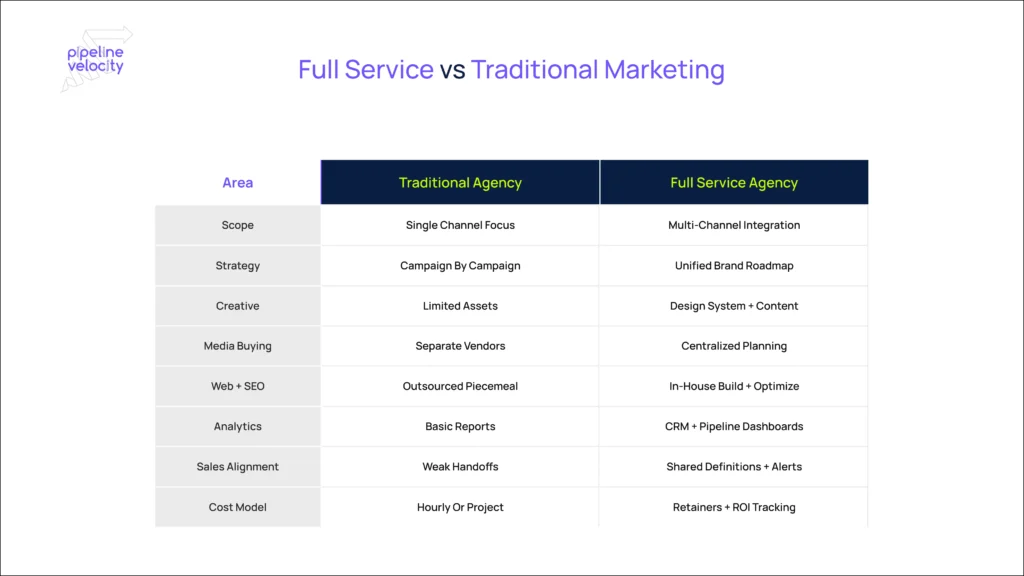
How Much Do Full Service Marketing Agencies Charge Usually
New York agencies charge more than smaller markets because overhead and talent costs run higher. You still control spend by setting clear scope and outcomes. Most retainers range from $5,000 to $25,000 per month for small to mid sized companies. Growth stage and enterprise brands often invest $30,000 to $100,000 per month when they need multi channel scale and heavy production. Projects like a brand identity or a website often price as a flat fee.
Common pricing models
Retainers cover ongoing strategy, creative, media management, and reporting. Projects cover one time builds like brand systems, websites, or product launches. Hourly work slots in when you need a specific specialist for a short time. Performance models set a base fee plus a bonus tied to agreed metrics such as qualified leads, revenue influenced, or return on ad spend. A clear model prevents surprises.
Example budgets by company size
A local service brand might invest $7,500 per month for search, social, and landing pages with light creative. A direct to consumer startup could invest $20,000 per month to run paid social, search, email flows, and biweekly creative refresh. A B2B SaaS company with a long sales cycle might plan $40,000 to $60,000 per month to cover content, paid media, events support, and sales enablement. An enterprise launch with TV, out of home, and a production heavy content slate can cross $100,000 per month.
What drives cost in New York City
Scope drives cost first. Timeline, asset volume, and the number of channels shape hours. Seniority also affects price because you pay for proven leads who can solve hard problems fast. New York location adds rent and salary pressure, and it brings access to niche talent like high end motion design and media buyers with large platform experience. You can still shape a smart plan by phasing work and keeping tests tight.
Hidden costs you should watch
Ask about stock, fonts, and third party tools. Ask how many revisions each deliverable includes. Ask how the team bills for travel, meals on set, and overtime during live events. Clarify media fees and whether the agency takes a percent of spend or charges a flat management fee. Clear terms protect the relationship and stop minor items from swelling the bill.
How to model return on investment
Tie each channel to a conversion goal and a dollar value. If you sell e commerce, connect ad spend to gross profit, not just revenue. If you sell B2B, connect form fills and demo bookings to qualified pipeline and closed revenue. Build a simple sheet that tracks cost per click, click to lead rate, lead to opportunity rate, close rate, and average deal size. Then review weekly so you scale winners and cut waste early.
Quick cost example
Say you invest $25,000 this month. You spend $12,000 on media, $10,000 on the retainer, and $3,000 on production. Your search program drives 6,000 clicks at $2 each. Your click to lead rate lands at 5 percent, so you earn 300 leads. Your sales team qualifies 30 percent or 90 leads. You close 20 percent of those or 18 deals. With an average margin of $1,500 per deal, you return $27,000 in gross profit. That beats your $25,000 outlay. You now know where to scale and where to improve conversion.
How To Choose the Best Full Service Marketing Agencies

You can pick a firm with confidence if you score teams against clear criteria. Start by defining outcomes, not outputs. You want pipeline, revenue, and share growth, not just ads and assets. Ask each agency to show work that mirrors your stage and industry. Test their thinking in a workshop, not just a slide deck. Insist on a plan for the first 90 days that your team can run with.
Build a sharp shortlist
Start with peers you trust and trade publications such as Ad Age for context. Pull case studies that match your channel mix. Look for clarity in how the team frames problems and outcomes. Favor agencies that publish specific results and show process, not just pretty pictures. New York shops that thrive tend to post clear frameworks and back claims with numbers. For a deeper framework, read our guide to choosing the right digital marketing agency in the United States.
Evaluate strategy depth
Ask agencies to walk you through research and planning. A strong team shows how they build personas from real interviews. They map the customer journey and flag friction you can fix fast. They set test plans with hypotheses and thresholds for a kill or scale decision. If the deck skips straight to tactics, push for the why and the numbers behind the plan.
Judge creative quality with fast tests
Run a short creative test. Ask for three headline directions, three visual styles, and one social carousel. Pick a landing page hero section and one email. Review how the work ladders up to the strategy. Great creative does not just look good. It also sets the promise, shows proof, and invites action.
Check channel mastery
Have media buyers explain how they structure search campaigns. Ask social teams to show budget shifts when a creative variant wins. Ask the SEO lead to audit one of your pages in real time. A capable team speaks in clear terms and ties each move to the numbers that matter.
Confirm measurement and tech stack fit
Ask how the agency connects ads, web analytics, and CRM data. Review a sample dashboard with channel, cohort, and funnel views. Confirm how they handle data privacy and consent. New York teams often maintain strong partnerships with analytics vendors. You benefit when the team can wire data end to end and find signal fast.
Score culture and communication
Meet the people who will do the work. Look for direct answers, tight notes, and firm deadlines. Ask how often you meet, what each meeting covers, and who attends. Clarity beats charm. You want a partner who writes crisp recaps and keeps projects on rails.
Run a pilot with a scoring rubric
Start with a 60 to 90 day pilot. Give a clear brief, a budget, and a performance goal. Score the team on plan quality, speed, creative strength, test design, reporting clarity, and results. Keep the pilot narrow enough to learn fast, yet broad enough to reveal how the team collaborates across disciplines.
Red flags that signal risk
Vague claims, missing numbers, slow follow up, and rotating teams point to trouble. Overly long contracts with no exit also raise risk. If the agency talks about awards more than results, keep looking. If scope lists everything under the sun, expect distraction. Pick focus and accountability.
A practical next step
If you want a calm, structured way to assess fit, request a planning workshop. Ask for a half day session that covers goals, audience, messaging, and a first test plan. You leave with a tangible brief whether you hire the agency or not. That small move protects budget and sets the tone for how you expect partners to behave.
Should You Consider a Full Service Marketing Agency for Your Company
You should hire a full service partner when growth goals outpace your team’s bandwidth or skill mix. You gain speed when one group drives strategy, creative, media, and measurement together. You also gain leverage because a broader bench can flex to seasonal peaks and launches. New York City brands often run many campaigns at once, so a unified team creates order and momentum.
Signs you should partner now
Your pipeline stalls because channels work in silos. Your brand looks different across touchpoints. Your media results swing because tests lack structure. You win small tests but fail to scale winners. Your team spends more time in status meetings than in focused work. These signals point to a need for one accountable team.
Signs you should wait
If you lack product market fit, hold off. If your leadership cannot commit to a 90 day plan, wait. If you have no bandwidth to review work weekly, a partnership will drag. If you cannot fund the first quarter without pressure, build core assets in house before you scale media.
Hybrid models that work well
Some brands keep strategy and creative in house and hire media and analytics outside. Others keep media and hire brand and production. The right split depends on your strengths and your goals. A full service agency can still lead the plan and run the gaps while your team covers key pieces. The goal is one plan, not one employer for every task.
A 90 day plan you can use
Month one, run discovery, rebuild your funnel view, and ship quick wins like landing page fixes and improved tracking. Month two, launch a creative refresh and two paid tests with clear hypotheses. Month three, scale the winner and roll out one larger asset such as a video or a guide. Hold weekly standups and a monthly review. Keep the dashboard simple so you can make decisions fast.
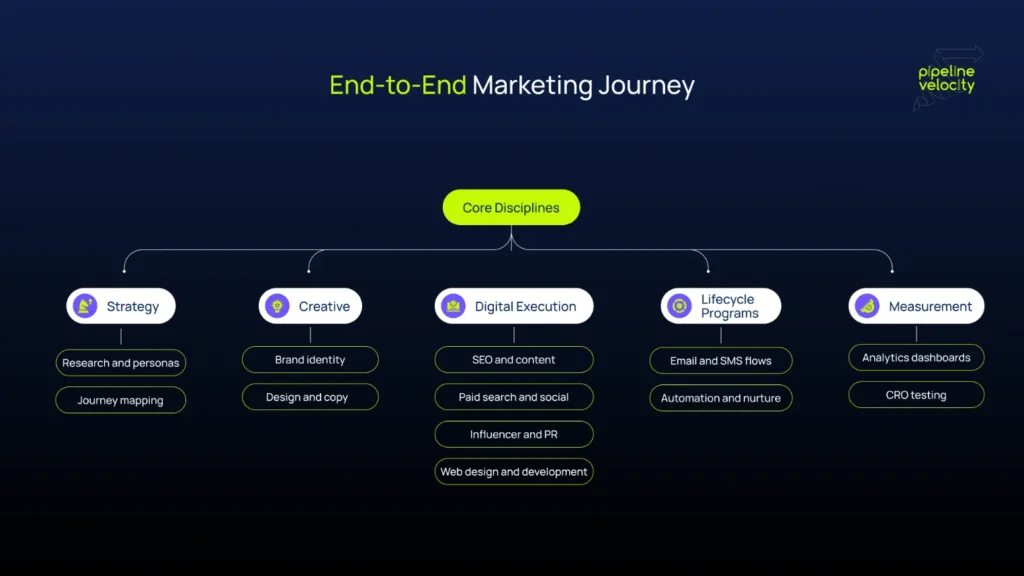
Two quick mini stories
A New York apparel startup hired a full service shop to unify TikTok creative, paid social, and email. Click through rates rose once the team aligned message and offer. Repeat purchases climbed after the agency fixed post purchase flows. A B2B fintech brand hired one partner to replace three vendors. The team cut duplicate spend, rebuilt attribution, and refocused content on buyer needs. Pipeline grew as sales and marketing met weekly on one truth set.
Work With Pipeline Velocity Before You Scale Spend
At Pipeline Velocity, we help you de risk growth with a short, focused start. Begin with a free marketing audit to spot quick wins and tracking gaps. If leadership needs senior guidance, bring in CMO as a Service to set goals, budgets, and a 90 day test plan. When sales ops and handoffs slow deals, our CRM management service cleans data and automates follow ups. If search and ads need to work together, use our integrated PPC and SEO programs so one team tunes bids, pages, and messages in lockstep. You get clear reporting, weekly action lists, and a plan that respects your cash and your calendar.
In summary…
You want a clear way to decide, budget, and act. This section condenses the playbook so you can use it today.
- What full service means
- One accountable team handles strategy, creative, media, web, and analytics.
- You gain speed and coherence across channels and assets.
- New York teams often bring deeper specialist benches.
- One accountable team handles strategy, creative, media, web, and analytics.
- What agencies do
- Plan with research, personas, and test road maps.
- Produce design systems, copy, video, and landing pages.
- Run search, social, influencer marketing, email, and PR.
- Measure with dashboards tied to pipeline and revenue.
- Plan with research, personas, and test road maps.
- What it costs
- Lean programs start near $5,000 per month.
- Growth stage scope lands at $20,000 to $60,000 per month.
- Enterprise launches can top $100,000 per month.
- Pick retainers for ongoing work and projects for one time builds.
- Lean programs start near $5,000 per month.
- How to choose
- Shortlist by relevant case studies and clear numbers.
- Test strategy depth, creative strength, and channel mastery.
- Confirm analytics, CRM, and privacy chops.
- Pilot for 60 to 90 days with a scoring rubric.
- Shortlist by relevant case studies and clear numbers.
- When to hire
- Hire when goals outpace bandwidth or skills.
- Wait if product market fit is shaky or leadership cannot commit.
- Run hybrid models if you want to keep key functions in house.
- Hire when goals outpace bandwidth or skills.
A smart plan beats guesswork. If you want a simple, no pressure starting point, book a planning session with a senior strategist and bring one real campaign to dissect. You leave with a testable plan and a clear view of cost and likely lift.
FAQs
What does a full service creative agency include?
It includes strategy, brand identity, design services, copy, video, web design and development, SEO, content, paid search, paid social, influencer marketing, email, PR, and analytics. One team plans, produces, launches, and measures work across channels so you move faster and avoid silos.
How much does a full service agency in New York cost per month?
Most retainers in New York range from $5,000 to $25,000 for small to mid sized brands and from $30,000 to $100,000 for growth stage and enterprise scope. Projects like a website or a brand system price as flat fees based on complexity and timeline.
Is a creative agency different from a marketing agency?
A creative agency centers on brand and content. A full service marketing agency covers creative plus media, SEO, email, analytics, and web. Many New York firms now operate as full service shops so strategy and execution sit together.
How long before I see results?
You should see leading signals within the first 30 days such as lower cost per click or higher click through rates. Pipeline impact usually lands within 60 to 90 days once tests reveal winners and you scale spend and creative around those insights.
Should I hire an agency or build in house?
Hire a partner if you need speed, breadth of skills, and a proven test plan. Build in house if you have stable channels, a steady creative engine, and leaders who can grow a team. Many brands pick a hybrid model so they keep strengths and rent the rest.

